Remember endless scrolling through blogs and dodging ads just to find answers? Those days vanished when ChatGPT went viral in 2022.
Instead of hunting for answers, we just type one question and get a clear answer.
Need to understand a hard research paper? Ask ChatGPT.
Want your resume to look amazing? Ask ChatGPT.
Not good at writing emails? Ask ChatGPT.
All of the things have been simplified with a couple of prompts.
But simply knowing ChatGPT exists isn’t enough. You need to understand how to use ChatGPT the right way.
In this blog, we’ll cover how to use ChatGPT in your daily life—whether you’re building a resume, summarizing a meeting, or simply trying to learn more efficiently.
We’ll also explore prompt-writing tips and the pros and cons of using ChatGPT.
Let’s dive in.
What Is ChatGPT?
ChatGPT is a conversational AI developed by the American company OpenAI in 2022.
A conversational AI is a type of artificial intelligence that is designed to understand and respond to human language in a natural, dialogue-like way.
ChatGPT is different from other technologies we have used before.
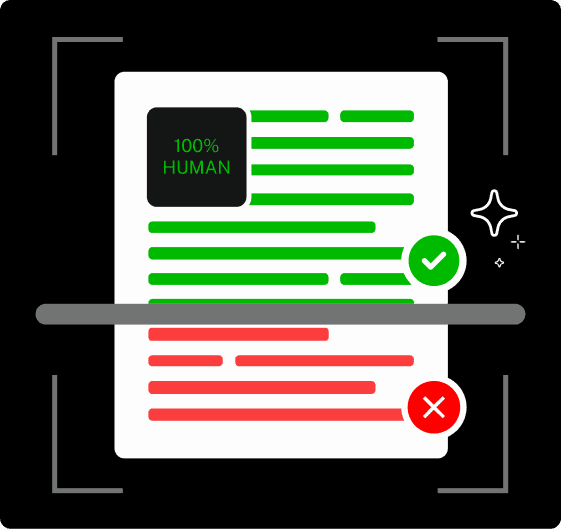

Never Worry About AI Detecting Your Texts Again. Undetectable AI Can Help You:
- Make your AI assisted writing appear human-like.
- Bypass all major AI detection tools with just one click.
- Use AI safely and confidently in school and work.
- It’s not like Google, which finds existing information on websites.
- It’s not like Siri or Alexa, which only work when you speak to them in certain ways.
ChatGPT creates brand-new responses just for you.
It doesn’t work as a typical search engine. Instead, it uses what it learned during training to write answers from scratch.
So, how does it do this?
How can a computer write essays, poems, code, and more without copying from somewhere else?
The secret is in its brain – a technology called GPT. The latest version, GPT-4, is what gives ChatGPT its abilities to understand and respond to almost anything you ask.
Overview of ChatGPT (powered by GPT-4)
The technology behind ChatGPT is GPT – short for Generative Pre-Trained Transformer.
Essentially, it’s the engine that powers everything ChatGPT does. At its core, GPT is its model called the “self-attention mechanism.”
This means the model can examine every word in a sentence and figure out how it relates to others.
Importantly, GPT doesn’t “think” like humans, but it mimics reasoning using advanced pattern recognition.
Because it was trained on vast amounts of internet data, GPT can identify and apply relationships between words, phrases, and concepts.
For example, if it has learned that A leads to B, and B leads to C, it can infer that A likely leads to C.
This layered process lets GPT provide well-structured answers that feel like real reasoning, even though it’s powered by patterns, not consciousness.
OpenAI has released several iterations.
- GPT-3.5 (The Free Tier)
If you’re using ChatGPT for free, you’re interacting with GPT-3.5. It is a capable language model with solid performance on everyday tasks.
- It can write emails, summarize articles, answer questions, and brainstorm ideas.
- It sometimes misses nuance, struggles with multi-step reasoning, and can lose context in longer chats.
GPT-3.5 is a strong starting point.
- GPT-4 (The Premium Version)
This version is available at ChatGPT Plus ($20/month). GPT-4 brings an upgrade in intelligence, consistency, and performance.
- It lets you create a personalized AI assistant tailored to your needs.
- It lets you upload documents and images for analysis, summarization, and data extraction.
- It interprets images, reads notes, or analyzes designs.
- It searches the web in real time to give you up-to-date answers.
- GPT-4o – (Omni Model)
OpenAI’s most advanced model to date is GPT-4o, short for “Omni”. It’s fast, multimodal, and starting to roll out to both free and paid users.
- It matches GPT-4’s reasoning but responds as quickly as GPT-3.5.
- It can process not just text, but images, voice, and video in supported environments.
- It’s built to enable live conversation—responding instantly, speaking naturally.
GPT-4o brings speed, smarts, and a more natural way to interact.
How to access ChatGPT
Here’s how you can access ChatGPT in three easy steps:
Step 1: Visit the Website
Open your browser and type in: chat.openai.com
You’ll see a page with a “What can I help with?” text and a text bar.
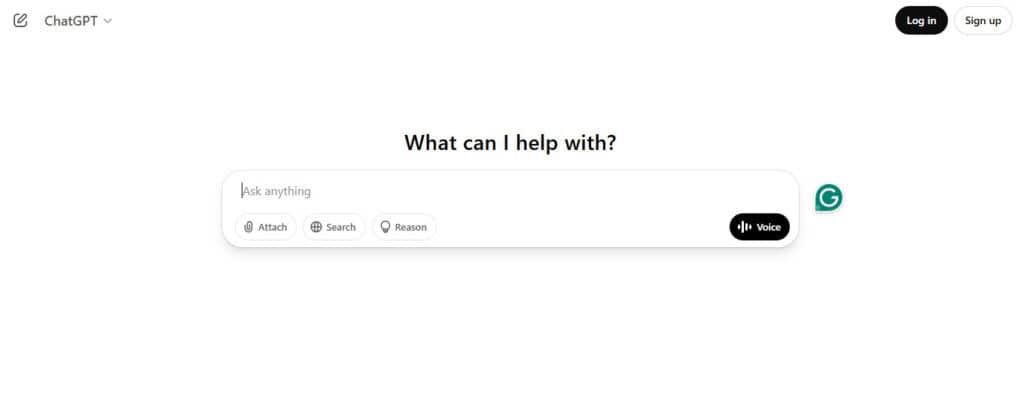
Step 2: Sign Up or Log In
If it’s your first time using this chatbot, click Sign Up in the top right corner.
You can sign up with your email, Google account, Apple ID, or phone Number
If you’ve already made an account before, click Log In instead. Once you’re in, you’re ready to start chatting.
Step 3: Choose How You Want to Use It
Use ChatGPT on different devices:
- On your computer (through the website)
- On your phone (download the free app from the App Store or Google Play)
But now comes the big question:
What’s free, and what’s paid? Well, there are two main versions:
| Plan | Model | Cost | Speed & Accuracy |
| Free | ChatGPT-3 | $0 | Good for basics |
| ChatGPT Plus | GPT-4 | $20/mon | Smarter, better memory, more accurate |
If you’re just exploring or doing small tasks, the free version is totally fine.
But if you’re working on something important—like writing resumes, studying complex topics, or using it every day—GPT-4 is worth it. It makes fewer mistakes and understands things better.
To upgrade, just click “Upgrade Plan” on the right side of the screen (on desktop) or under “Settings” in the app.
It’ll guide you through payment, and once it’s done, you’ll see a small GPT-4 tag next to the model you’re using.

How Can You Use ChatGPT?
Since its launch, ChatGPT has been used for several reasons—writing content, answering questions, solving coding issues, and even helping kids with their homework.
Let’s explore three creative ways by which you can use the ChatGPT search engine:
1. To Rehearse Tough Conversations
There are moments when you just don’t know what to say—like asking for a raise, firing a difficult client, or addressing a tense team issue.
Explain the situation to ChatGPT, and it will play both roles—yours and theirs—so you can practice how the conversation might unfold.
Example Prompt
- I need to tell a long-time client their contract is ending due to a budget shift. Can you roleplay how to say it kindly but clearly?
2. To Use Mental Models
When you’re stuck on a decision—personal or business—ChatGPT can break things down using time-tested mental models.
Example Prompt
- Should I quit my stable job to pursue a startup idea I’ve been sitting on? Help me think this through using opportunity cost and probabilistic thinking.
3. To Get Feedback
Launching something new?
Before testing it on actual humans, you can ask ChatGPT to simulate responses from different types of people—ideal customers, skeptics, even distracted scrollers.
Unlike a traditional search engine, ChatGPT can provide personalized feedback.
Example Prompt
- Act like a time-starved solopreneur with shiny-object syndrome. What would make you stop and read this Facebook ad?
How to Use ChatGPT for Work Tasks
A recent survey shows 30% of U.S. workers are saving 5–8 hours every week using ChatGPT, and 94% of them are putting that time right back into doing better work.
Here’s how you can use ChatGPT search engine for work:
1. To Write Better Emails
Don’t reword, re-read, and rephrase emails all day. ChatGPT can draft, shorten, or polish your emails in seconds, while keeping your tone sharp and professional.
Example Prompt
- Here’s a rough email draft I wrote to a potential client who ghosted after the proposal. Rewrite it to sound confident and re-engage them, without sounding desperate. Keep it under 150 words. [Insert draft]
2. To Make Meeting Notes
Nobody wants to sift through a messy meeting transcript. Paste your notes or voice-to-text dump into ChatGPT and ask it to summarize key decisions, action items, and next steps.
Example Prompt
- Here’s a rough transcript from our Monday marketing meeting. Can you extract key takeaways, who’s responsible for each action, and any blockers mentioned? [Insert notes or transcript]
3. To Write Reports or Proposals
Whether it’s a client proposal, internal report, or project update, ChatGPT can turn your outline or notes into well-structured and clear writing.
Example Prompt
- Write a 1-page project update based on these bullet points. The audience is a non-technical VP. Keep it concise and professional, with clear next steps at the end. [Insert bullet list]
4. To Explain Complicated Data
Feed ChatGPT a data summary or key metrics, and ask it to translate the findings for a leadership update or client recap.
Example Prompt
- Summarize the following campaign performance data in plain English for our CEO. Highlight what’s working, what needs improvement, and 2 strategic suggestions based on the numbers. [Insert metrics or summary]
Forbes has suggested 5 Ways to Use ChatGPT for Work. Read The Full Article.
Here’s a word of caution…
Yes, ChatGPT is fast. Smart. And wildly useful.
But it can still make mistakes—like inventing facts, misinterpreting tone, or missing context.
So here’s the rule:
When using it for public-facing work (like client emails, press releases, or financial reports), treat it like a brilliant intern: let it do the grunt work, but always review before you hit send.
How to Use ChatGPT for Studying and Learning
Sure, ChatGPT helps find quick answers—but are you using it to make your studying easier (or maybe a little less painful)?
Here are the three ways by which you can make your studying and learning easier.
1. To Summarize Study Material
Textbooks are overwhelming—too much information, too little time. Use ChatGPT to break down the concepts for you, and save your energy and time.
Example Prompt
- Summarize this chapter by identifying the main ideas, key arguments, and any important examples. Format the summary into clear, concise bullet points, and prioritize information that would be most useful for studying or quick revision.
2. To Create Custom Quizzes
One of the best ways to study is by testing yourself. ChatGPT makes quiz-making easy and personalized.
Example Prompt
- Create a 10-question quiz on cell biology, with multiple-choice options and the answers at the end.
3. To Explain Difficult Concepts
Knowing how to use ChatGPT 4o for complex topics can transform your learning experience, as it provides more nuanced and multimodal explanations than previous versions.
Example Prompt
- Explain quantum physics like I’m 12.
And when it comes to writing up an essay in a structured way, consider using an AI Essay Writer to create well-organized, A+ essays in just seconds.
Here’s how it can help:
- Just provide a topic, word count, and essay style, and watch the AI create a complete, factually accurate draft in seconds.
- You can specify the tone, essay format, or type of language you want (formal, academic, casual, etc.).
The AI is trained to write well-structured, grammatically correct essays. It helps you skip the hours of stress, research, and procrastination.
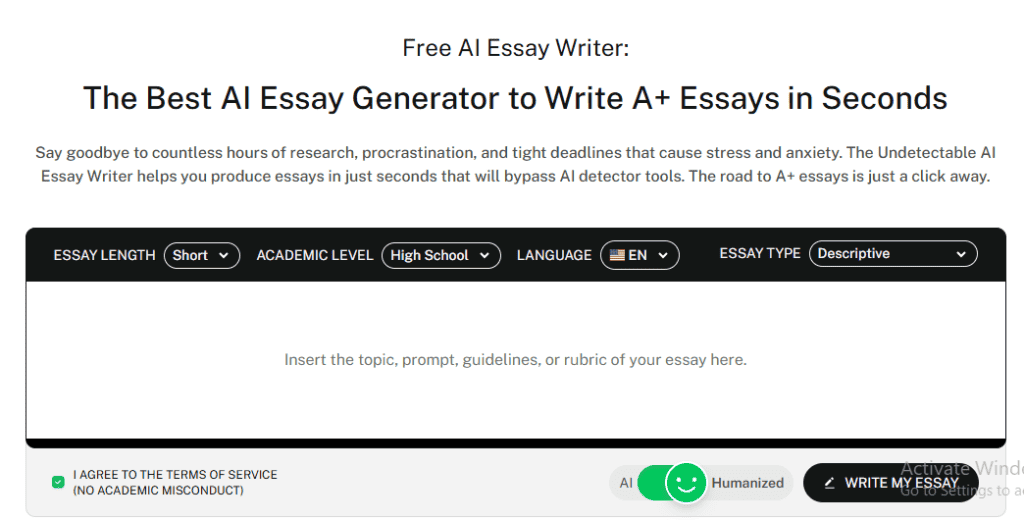
4. To Understand Grammar
When you want help with writing or understanding grammar rules, be as direct as possible.
ChatGPT responds best to clear prompts.
Example Prompt
- Teach me how to use commas correctly.
- Can you quiz me on past-tense verbs?
- Explain the difference between ‘affect’ and ‘effect.’
5. To Stay Organized
Studying is not just about learning—it’s also about staying on track. ChatGPT can help you plan out study sessions, set reminders, and stay organized.
For example, ask it:
- Create a study plan for my biology test next week.
- Help me set a goal to finish reading the next chapter by tomorrow.
- Give me a 20-minute study session guide, followed by a 5-minute break.
PratapSolutions has suggested 25 Secret ChatGPT Prompts For Students. Read The Full Article Here.
How to Use ChatGPT to Build a Resume
“What do I even put in the resume? Am I good enough?”
Building a resume is a daunting task.
It’s tough to highlight all your accomplishments and skills in a way that grabs the attention of employers.
But knowing how to use ChatGPT for resume creation can make this process much easier and more efficient.
You can use ChatGPT…
1. To Draft Your Resume
Ask ChatGPT to write a resume based on your career and experience. For example, you might ask:
- Write a resume for a marketing manager with 5 years of experience in digital advertising, SEO, and campaign management.
2. To Write Professional Points
Do you have a long list of notes, but you’re not sure how to make them sound polished? No problem. Take your rough work notes and feed them to ChatGPT.
Example Prompt
- Turn these notes into bullet points for my resume: Managed campaigns, worked with clients, improved metrics.
3. To Customize Your Resume For Each Job
One of the most important things you can do when learning how to use ChatGPT for resume building is tailoring your resume to each specific job you’re applying for.
ChatGPT can help with this.
Here’s how:
- Paste the job description into ChatGPT.
- Provide your current resume.
- Ask:
- Can you customize my resume based on this job description?
One smart way to combine ChatGPT with specialized AI tools to streamline the entire job application process:
- Start with ChatGPT
Use ChatGPT to brainstorm and organize your achievements, skills, certifications, and job experiences.
Example prompt:
- Help me list my top achievements in digital marketing for my resume.
- Build Your Resume with AI Resume Builder
Once you have the raw material, use an AI Resume Builder to format it into a polished, professional resume tailored to your desired roles.
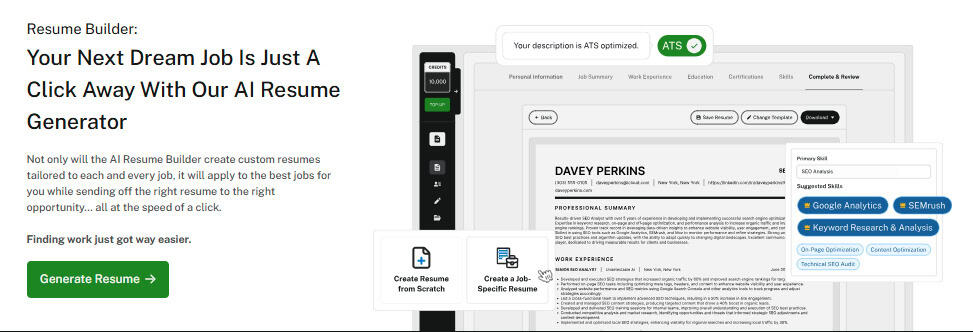
- You simply input your details—education, experience, skills—and the tool structures it perfectly for you.
- Craft Your Cover Letter with AI Cover Letter Generator
Instead of writing a fresh letter for every job, use your resume points to generate customized cover letters aligned to each job description.
- Just paste the job title and a few specifics about the company, and the tool personalizes it.
- Apply Smarter with AI Job Applier
Skip the repetitive work. Use our Smart Applier to autofill applications based on your resume and cover letter, ensuring consistency and saving you hours.

While you’re here, don’t forget to explore our AI Detector and Humanizer in the widget below!
Prompt Tips: Get Better Answers from ChatGPT
You might have heard the saying: “ChatGPT rewards those who ask better questions.”
It’s true—at its core, prompt engineering is simply the art of asking the right questions.
Let’s explore how to use ChatGPT more effectively to get more accurate, helpful, and clear answers.
1 – Give ChatGPT a Job
Sometimes, it helps to tell ChatGPT what “role” to play. This technique guides it to respond with the tone, perspective, or expertise of a specific role.
For example, ask ChatGPT to:
- Act as a hiring manager and explain what makes a resume stand out.
- Act as a digital marketing consultant and provide me with a strategy to boost e-commerce sales for a fashion brand.
2 – Provide Specific Prompts
The more specific you are, the better the response you’ll get. Let’s compare two examples:
Vague Prompt: Tell me about climate change.
Specific Prompt: What are the main causes of climate change, and how do they affect coastal cities?
See the difference? The second prompt helps ChatGPT focus its answers, making it much more targeted and useful.
3 – Give ChatGPT the Bigger Picture
To get even better answers, provide context about what you’re asking. This allows ChatGPT to tailor its response to your situation.
For example,
- I’m working on a research paper about renewable energy. Can you explain how solar panels work, but focus on the technological advancements in the past 10 years?
- I’m preparing a business plan for a new coffee shop in a suburban neighborhood. Can you suggest some marketing strategies that would work well for this type of community?
Now, let’s explore a simple framework for structuring your prompts for better answers:
- Role → Task → Context → Style
For example,
- Act as a teacher. Explain the concept of quantum computing to a complete beginner, in simple terms, so that someone without a technical background can understand.
By using this framework, you’ll start getting more accurate, helpful responses in no time.
Pros and Cons of Using ChatGPT
Everything comes with its own set of advantages and challenges, and ChatGPT is no different. It’s important to weigh both sides to use it effectively.
Let’s dive into the pros and cons!
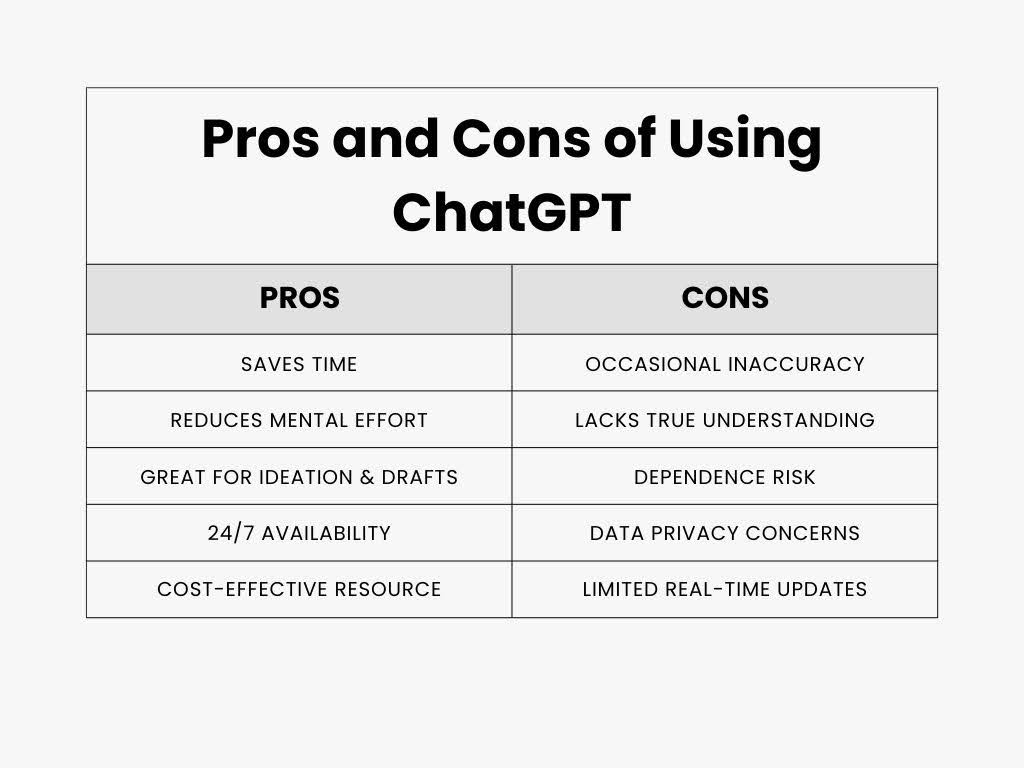
Here’s a quick reference table that helps you understand when ChatGPT shines and when to steer clear of using it.
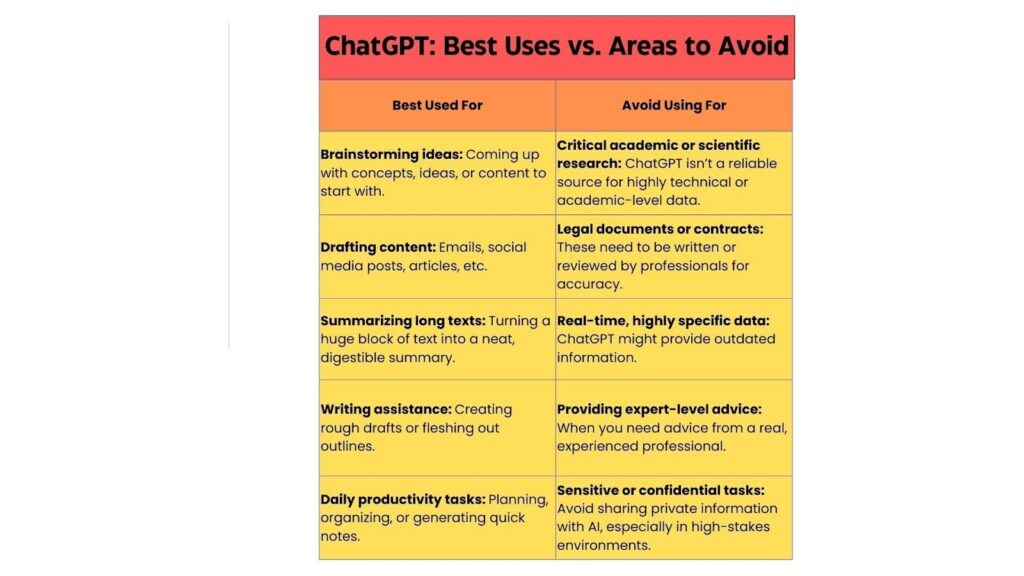
FAQs
Is ChatGPT accurate for technical or school topics?
Reasonably, but always verify with primary sources. It’s a generalist, not a subject-matter expert.
Can I use ChatGPT on mobile?
Yes, available on both iOS & Android. Seamless sync via login.
Will using ChatGPT for school be considered cheating?
Depends on the institution. Emphasize use as a study tool, not a shortcut. Add a note on academic integrity.
Final Thoughts
So, what’s the real deal with ChatGPT?
After seeing everything it can do, the real question isn’t if you should use it — it’s how you’re using it to make your life easier.
ChatGPT isn’t like a normal search engine that just spits out links.
It creates things for you — whether you’re writing emails, studying tricky subjects, or even building your resume.
It saves you tons of time if you use it the right way.
And it’s getting even better. With the new GPT-4o version, ChatGPT is faster, smarter, and easier to talk to.
Of course, it’s not perfect. It can still make mistakes.
But if you’re smart about it — if you use clear instructions and a little creativity — ChatGPT can be a real game-changer for school, work, and even your personal projects.
So… what could you create with ChatGPT today? Honestly, the only limit is what you can dream up.
